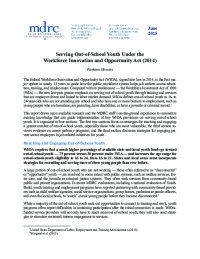Serving Out-of-School Youth Under the Workforce Innovation and Opportunity Act (2014)

The federal Workforce Innovation and Opportunity Act (WIOA), signed into law in 2014, is the first major update in nearly 15 years to guide how the public workforce system helps job seekers access education, training, and employment. Compared with its predecessor — the Workforce Investment Act of 1998 (WIA) — the new law puts greater emphasis on serving out-of-school youth through training and services that are employer driven and linked to labor market demand. WIOA defines out-of-school youth as 16- to 24-year-olds who are not attending any school and who have one or more barriers to employment, such as young people who are homeless, are parenting, have disabilities, or have a juvenile or criminal record.
This eight-page report draws upon available research and the MDRC staff’s on-the-ground experience to summarize existing knowledge that can guide implementation of key WIOA provisions on serving out-of-school youth. It is organized in four sections: The first two sections focus on strategies for reaching and engaging a greater number of out-of-school youth, especially those who are most vulnerable; the third section reviews evidence on career pathway programs; and the final section discusses strategies for engaging private sector employers in job-related initiatives for youth.






